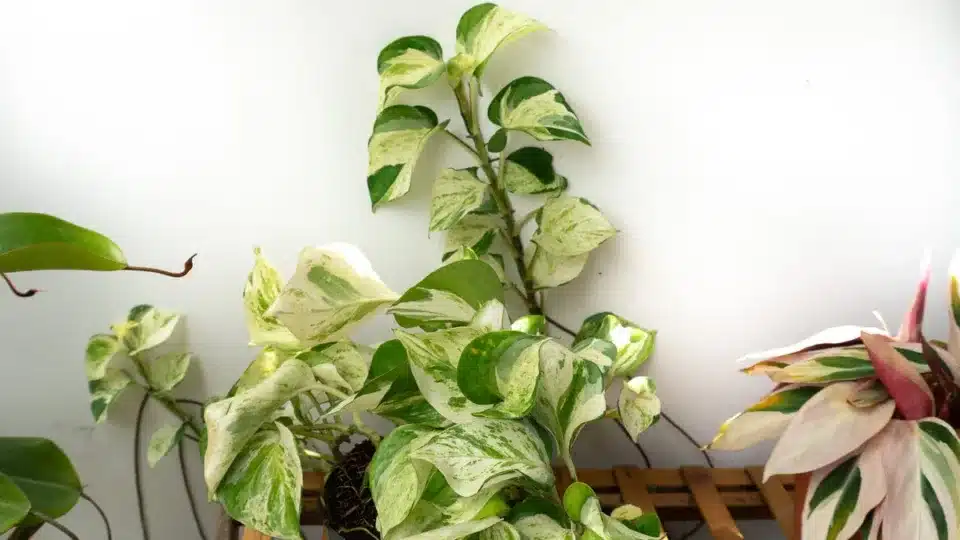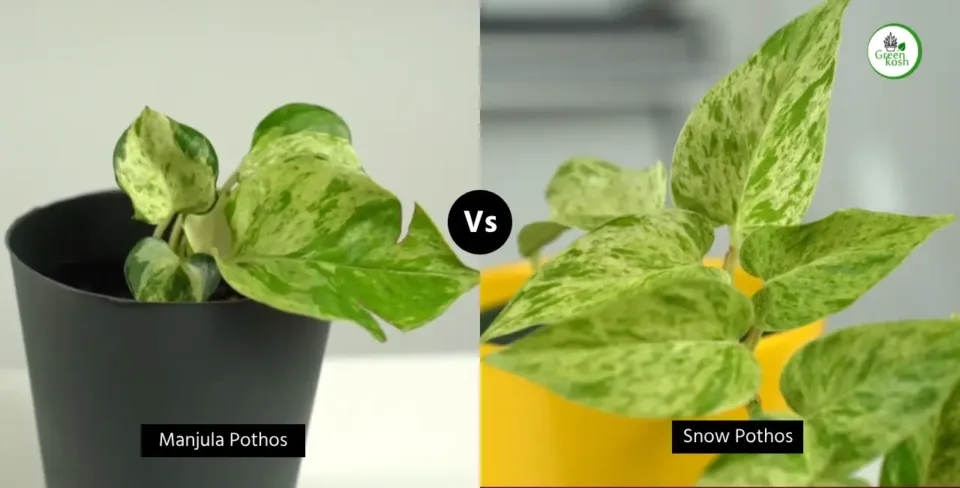Manjula Pothos, scientifically known as Epipremnum aureum ‘Manjula,’ is a stunning and highly sought-after variety of the classic Pothos plant. Its unique variegation sets it apart from other Pothos cultivars, making it a favorite among houseplant enthusiasts and collectors.

The Manjula Pothos features large, heart-shaped leaves with beautiful splashes of creamy white, silvery-grey, and green colors, creating an eye-catching display of foliage.
Care Guide for Manjula Pothos
Manjula Pothos is a reasonably simple plant to maintain, making it a great option for both novice and seasoned plant enthusiasts. Here are some essential care tips to ensure your Manjula Pothos thrives:
- Light Requirements: Manjula Pothos thrives in bright, indirect light. Avoid leaving it out in the sun for too long because that will scorch the leaves.
- Temperature: The plant prefers temperatures between 65°F to 85°F (18°C to 29°C). Please protect it from drafts and sudden temperature fluctuations.
- Watering: Prior to watering the plant, let the top inch of soil dry out. Underwatering can make the plants droop while overwatering might result in root rot. Strike a balance and adjust watering according to the season.
- Humidity: Manjula Pothos enjoys moderate to high humidity levels. By frequently spraying the leaves or placing a humidifier nearby, you can raise the humidity.
- Soil: Well-draining, rich potting soil works best for Manjula Pothos. Vermiculite, perlite, and peat moss are good combinations.
- Fertilizer: Once in a month during the growing season (spring & summer), fertilize the plant with a balanced liquid fertilizer. Reduce or stop fertilizing in fall and winter when the plant’s growth slows.
- Pruning: Regularly prune your Manjula Pothos to encourage bushier growth and maintain its desired shape. Trim yellow or damaged leaves to promote overall health.
- Propagation: Manjula Pothos can be easily propagated through stem cuttings. Take a healthy cutting with at least two leaves and place it in water or moist soil until it develops roots.
- Potting and Repotting: Every one to two years, or when it outgrows its current container, repot the plant. Choose a slightly larger container with good drainage.
Manjula Pothos vs. N’Joy
When comparing Manjula Pothos and N’Joy, their appearances stand out as the most apparent difference. Manjula Pothos features large, uniquely variegated leaves with captivating splashes of cream, gray, and green colors. On the other hand, N’Joy, also known as Epipremnum aureum ‘Njoy,’ displays smaller leaves adorned with crisp white variegation against a dark green background.

Moreover, their growth rates differ, with N’Joy tending to be a slower grower compared to the relatively faster growth of Manjula Pothos. While both varieties have similar care requirements, Manjula Pothos may require slightly higher humidity due to its larger leaves and more intricate variegation. Additionally, it’s worth noting that Manjula Pothos might be harder to find compared to the more commonly available N’Joy in nurseries and garden centers.
Manjula Pothos vs. Snow Queen
When comparing Manjula Pothos and Snow Queen Pothos (Epipremnum aureum ‘Snow Queen’), the first notable difference is in their leaf sizes and shapes. Manjula Pothos boasts larger, heart-shaped leaves, while Snow Queen exhibits smaller, lance-shaped leaves.

The variegation patterns also set them apart, with Manjula Pothos showcasing a mix of cream, gray, and green colors, and Snow Queen displaying white variegation on its green leaves. Despite these differences, both plants have similar care requirements and will thrive with proper attention to light, water, and humidity.
Manjula Pothos vs. Marble Queen
Manjula Pothos and Marble Queen (Epipremnum aureum ‘Marble Queen’) have distinct variegation patterns, with Manjula Pothos featuring intricate splashes of cream, gray, and green, while Marble Queen exhibits marbled white variegation on its green leaves.

Another difference lies in their leaf sizes, with Manjula Pothos having larger leaves compared to Marble Queen’s smaller to medium-sized ones. Despite these differences, both plants share similar growth rates under appropriate conditions and are generally easy to care for.
Conclusion
In conclusion, the comparison between Manjula Pothos and its counterparts – N’Joy, Snow Queen, and Marble Queen – reveals unique characteristics that make each plant stand out in its own right. Whether it’s the captivating variegation of Manjula Pothos, the simplicity of N’Joy, the lance-shaped leaves of Snow Queen, or the classic marbled variegation of Marble Queen, each variety brings its own charm and beauty to indoor spaces. Regardless of the choice, all of these Pothos cultivars are excellent additions to any plant collection and can thrive with proper care and attention.
Most common FAQs
Q1: Is the Manjula pothos rare?
Yes, the Manjula Pothos is considered relatively rare compared to other Pothos varieties, which contributes to its popularity among houseplant collectors.
Q2: Why is Manjula Pothos expensive?
The Manjula Pothos is expensive due to its rarity and high demand. Its unique variegation and limited availability contribute to its higher price in the market.
Q3: Is Manjula pothos a lucky plant?
Yes, Manjula Pothos is often regarded as a lucky plant and is believed to bring good fortune and positive energy to the space it occupies.
Q4: Is the Manjula pothos poisonous?
Yes, like other Pothos varieties, Manjula Pothos is toxic to pets and humans if ingested. It contains calcium oxalate crystals that can cause mouth and gastrointestinal irritation. Keep it out of reach from curious pets and children.
